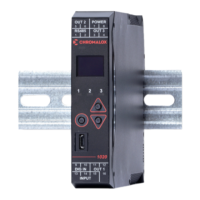2
2 Electrical Installation
The installation should be only performed by
technically competent personnel.
It is the responsibility of the installing engineer
to ensure that the configuration is safe.
Local Regulations regarding electrical installa-
tion & safety must be observed (e.g. US Nation-
al Electrical Code (NEC) or Canadian Electrical
Code).
2.1 Installation Considerations
Ignition transformers, arc welders, motor drives, me-
chanical contact relays and solenoids are examples of
devices that generate electrical noise in typical indus-
trial environments.
The following guidelines MUST be followed to mini-
mise their effects.
If the instrument is being installed in existing equip-
ment, the wiring in the area should be checked to en-
sure that good wiring practices have been followed.
Noise-generating devices such as those listed above
should be mounted in a separate enclosure.
If this is not possible, separate them from the instru-
ment, by the largest distance possible.
If possible, eliminate mechanical contact relays and
replace with solid-state relays. If a mechanical relay
cannot be replaced, a solid-state relay can be used to
isolate the instrument.
A separate isolation transformer to feed only the in-
strumentation should be considered. The transformer
can isolate the instrument from noise found on the AC
power input.
2.2 AC Power Wiring - Neutral (for
100 to 240V AC versions)
It is good practice to ensure that the AC neutral is at or
near ground (earth) potential. A proper neutral will help
ensure maximum performance from the instrument.
2.3 Wire Isolation
Four voltage levels of input and output wiring may be
used with the unit:
• Analogue input (for example thermocouple, RTD,
VDC, mVDC or mADC)
• Relays outputs
• SSR Driver outputs
• AC power
The only wires that should run together are
those of the same category.
If any wires need to run parallel with any other lines,
maintain a minimum space of 6” between them. If wires
MUST cross each other, ensure they do so at 90 de-
grees to minimize interference.
2.4 Use of Shielded Cable
All analog signals must use shielded cable. This will
help eliminate electrical noise induction on the wires.
Connection lead length must be kept as short as pos-
sible keeping the wires protected by the shielding. The
shield should be grounded at one end only. The pre-
ferred grounding location is at the sensor, transmitter
or transducer.
2.5 Noise Suppression at Source
Usually when good wiring practices are followed, no
further noise protection is necessary. Sometimes in
severe electrical environments, the amount of noise is
so great that it must be suppressed at source. Many
manufacturers of relays, contactors, etc. will supply
‘surge suppressors’ which mount on the noise source.
For those devices that do not have surge suppressors
supplied, Resistance-Capacitance (RC) networks and/
or Metal Oxide Varistors (MOV) may be added.

